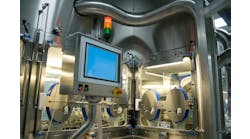Managing any sector of the supply chain in 2015 has got to be one of the toughest jobs in the United States right now. Not only are you expected to make, store and move products through your facilities and distribution networks on-time, every time and within budget, but you have to do that while juggling umpteen other responsibilities—labor management, technology implementations and upgrades, maintenance, safety, global competition, paradigm shifts (the Internet of Things, omni-channel, alternative fuels, Big Data, the Cloud)—while figuring out exactly how you're going to be able to comply with the next round of government regulations when you're still trying to adapt to the last set of regs. Well, you knew this job was dangerous when you took it.
Trying to make some sense of it all, and continuing an annual tradition, MH&L recently gathered the thoughts and prognosticating skills of members of its Editorial Advisory Board on the current state of material handling and logistics, and where the industry seems to be headed.
Participating in the 2015 roundtable, in alphabetical order, are:
Russ Meller, vice president of R&D, Fortna
Tan Miller, director of the Global Supply Chain Management Program, Rider University's College of Business Administration
Alex Scott, senior research associate, Opex Analytics, and Ph.D. student in supply chain management at Penn State University
David Sparkman, founding editor of ACWI Advance
Jim Tompkins, CEO, Tompkins International
Al Will, retired Marine Colonel, logistics specialist, and president, PWG Distribution Solutions.
Automation & Robotics
MELLER: Companies are looking to automation to fill gaps in the labor force and increase efficiencies in distribution. The cost of doing so has almost reached a tipping point. As technology costs come down and the cost of labor increases, we'll see more companies investing in automation.
Justifying investments is not just about speed or accuracy anymore. It's about driving top-line revenue from service improvements like same-day shipping, taking inventory out of the supply chain through faster replenishment to stores, and reducing capital costs through more efficient use of space.
Amazon put 15,000 goods-to-person robots (i.e., Kiva bots) in its fulfillment centers. Why make that kind of investment? 1) Because these bots allow them to pick two to three times faster than before; 2) the bots enable shelves to be stacked closely together for greater storage density; and 3) Amazon expects to see 20% operating cost reductions at facilities that use them.
Improvements in vision systems (sensors), information processing and machine learning (intelligence), and precision mechatronics (movement) are changing the way we look at robotics. Robots that can see, think and act precisely are capable of a wider range of tasks, and when you combine that with a robot's inherent accuracy, consistency and capacity for uninterrupted work with zero ergonomic considerations, you get a recipe for real productivity gains.
Today robots are being used to load and unload trailers, palletize and depalletize, and move products via automated guided vehicles (AGVs). Now, we are seeing robots capable of each picking with vision systems that allow them to adapt to a changing environment and even determine the best way to pick up and handle uniquely shaped items. And as robots are becoming smarter and more capable, more controls are being placed in the hands of operators to program and reprogram without the assistance of systems specialists.
: Automation of warehouse tasks generally provides improvements in efficiency and accuracy. Coupled with new equipment must be the training of personnel in proper operation and new procedures. This must be followed up with adequate supervision.
Recently, a major manufacturer of telescoping dock loading/unloading conveyors observed employees at a major retailer's distribution center utilizing the newly installed loaders. It was obvious the retailer had not developed new procedures and set new objectives for employees to follow once the new dock loading/unloading conveyors were installed. People were the afterthought. Employees spent much of their time moving boxes at accumulation points on the feed conveyor rather than inside shipping trailers stacking the boxes delivered by the telescoping loader, which resulted in slowed loading times.
Truck Driver Shortages
In terms of a capacity crunch and based on an analysis of hundreds of thousands of truckload shipments, 2015 appears to be much looser capacity-wise than 2014. 2014 was affected by an expanding economy—which causes trucking capacity shortages because trucking generally trails the economy—and weather issues in the first quarter of the year. Freight rejections and spot prices are down in 2015 as compared to 2014, both strong indicators that capacity is not a major issue right now. The loosening of the market is reflected in the stock prices of the major trucking companies—prices have returned to mid-2014 levels, following a sharp increase towards the end of 2014 and a subsequent retreat in the first half of 2015.
As of now, I do not see a major driver shortage issue. This is due to a few things: 1) trucking companies increased wages and hiring bonuses in 2015, successfully attracting more drivers; 2) the decrease in fracking, which draws from the same labor source as trucking; and 3) general economic malaise for the first half of 2015 (and hence less competition for labor).
LTL and other drivers that return nightly have a turnover rate of about 20%. Over-the-road (OTR) drivers that are away from home for a couple of weeks at a time have a turnover rate of over 100%. My point is that although there are many reasons for the driver shortage, a significant one is that it's a tough career, especially for OTR drivers. Initiatives like the Physical Internet that enable a greater degree of horizontal collaboration may someday make it possible to return every driver home every night, which will at least address this aspect of driver shortages.
Panama Canal Expansion
WILL: The completion of the Panama Canal expansion project during 2016 will impact distribution strategies within the U.S. There will most certainly be a shift of cargo currently entering via the West Coast to entering via the East Coast. However, there are various predictions as to how much.
Price-sensitive items will probably favor using the Panama Canal route to get to inland population density centers while time-sensitive items may very well continue using the West Coast ports. It is cheaper to move cargo via ship but slower. Competition between the five major East Coast ports will intensify the need for improvements in rail and road infrastructure supporting those ports. Distribution centers will also be necessary to support the increased port traffic.
TOMPKINS: The Panama Canal expansion will lead to more freight traveling to the eastern U.S. ports and less to the western U.S. ports. More distribution centers and fulfillment capacity will be required on the U.S. East Coast. Getting products to the East Coast for less transportation dollars will lead companies to evaluate their existing networks.
Near-Shoring
There is still a lot of bad information out there. Yes, 5% of manufacturing jobs are coming back to the U.S. (re-shoring) or to Mexico (near-shoring). But 8% of U.S. manufacturing is moving offshore, so at the end the day more work is leaving than coming.
Firms are going beyond purchase price or total landed cost (TLC) and are looking at total delivered cost (TDC).
And more and more firms are moving from outsourcing their sourcing to direct sourcing and then to strategic sourcing and thus taking greater control of their end-to-end supply chain.
Controlling Freight Costs
SCOTT: Recently, MIT's Chris Caplice discussed the lack of a "market rate" for a lane. I fully concur, as the cost to haul a truckload of goods is affected by many factors (he cites, to name a few, origin and destination, operational characteristics, and payment terms). The basic assumption is a flat rate for a year, which is of course how most truckload rates are negotiated and managed. But I think the analysis can go a step further—the cost to haul a truckload of goods is not only affected by those factors mentioned, but also the status of the market at the time a load is hauled.
For example, in the buildup to Memorial Day, a carrier has many freight options—the market is in his favor. However, in February, a carrier is desperate for freight and does not have many outside options. So while there is not truly a "market rate," there is not even a "market rate" that is constant across time, because one needs to consider the opportunity cost for a carrier.
The idea of estimating a "market signal"—i.e., can we estimate supply and demand conditions in near-real-time, at a high level of geographical granularity?—is research that I am currently working on. Interestingly, even though there is not a centralized market for truckload transportation, spot prices appear to move together—implying an implicit market.
MELLER: Next to inventory, transportation is the second largest supply chain cost a company has (often 20% or more). Parcel suppliers are showing an unwillingness to bear the full cost of higher customer expectations. They're changing the model with peak and dim weight pricing strategies. Companies must respond by re-evaluating their networks and making smarter inventory decisions to reduce the distance (and time) between products and customers.
Third-Party Logistics Strategies
TOMPKINS:
- The requirement for quicker delivery to e-commerce clients will beget more opportunity for 3PLs to operate multi-tenant facilities located close to high density cities.
- A hybrid strategy for companies involved in e-commerce for the top tier Metropolitan Statistical Areas (MSA), mid-tier MSA and rural areas.
- There will be a greater need for 3PLs to provide both local inventory and local delivery capabilities.
- Greater need for 3PLs to interface with access points, click & collect and lockers in mid-tier MSA.
- Greater need for 3PLs to be involved in supply chain visibility solutions, demand-driven supply chain solutions and order management solutions.
- The requirement for quicker delivery to e-commerce clients will beget more opportunity for 3PLs to operate multi-tenant facilities located close to high-density cities.
WILL: We continually observe companies contracting 3PL providers but not giving that provider specific requirements and expectations. Companies needing 3PL services must clearly articulate current basic service needs and potential future service needs to 3PL providers, to include documentation of information flow. The 3PLs will then clearly understand expectations and be better able to provide the value the client is seeking.
Next-Day/Same-Day Delivery
MELLER: Faster fulfillment can create a virtuous cycle where companies can take inventory out of the supply chain though smaller, more frequent deliveries to stores, and open up selling space for a broader SKU assortment. In this way a faster fulfillment cycle with guaranteed service creates opportunities to both grab new share in your existing customer base and also to take market share from your competitors.
Customer expectations for faster service and better tracking of deliveries will also make winners out of disruptors offering crowd-sourced last-mile solutions that are both agile and require no capital investment, like Uber and Deliv.
Companies need to get a handle on "how fast is fast enough?" from their customers' perspective. It's not same-day or even next-day for every business. It's important to understand the expectations of your customer base before making investments for speed. The ripple effect of speed is felt throughout the entire organization; it's not just the DC, it's systems, merchandising, transportation, etc. So think about the upstream and downstream processes that are impacted when you increase distribution speed.
Omni-Channel Distribution
TOMPKINS: The evolution of omni-channel logistics has begot:
- More frequent shipments of smaller orders.
- More "each" picking/packing/shipping.
- Distribution centers (DC) being combined with fulfillment centers (FC) and, when really done well, DCs and FCs combined with returns centers (RC) and liquidation centers (LC).
- Increased peaks throughout the year having different capabilities and therefore requiring different solutions.
- Higher levels of automation and adaptability.
- The desire for lean material handling system design, where more innovation/creativity is required to design and implement lower cost material handling solutions to work across a wider variety of operating scenarios.
- Increased sophistication of warehouse execution systems.
MELLER: While only 5-7% of sales come through the ecommerce channel, half of U.S. retail sales are now influenced by digital channels. Customers are going online to find products, check inventory availability, and make purchase decisions before they ever step foot in a store to finish the sale. With competitors only a click away, the experience has to be seamless and the inventory has to be where you say it is. There's not a lot of room for error.
For online customers the buy button is easy; everything behind that is complex. 80% of omni-channel strategy is about inventory strategy. It comes down to making intelligent inventory allocation decisions across the network and building flexibility to quickly realign inventory when demand comes from unexpected places.
And then there are the challenges associated with integrating all the systems (WMS, WCS, DOM, ERP, etc.) required to deliver on your customer promise without sacrificing accuracy, speed, or brand integrity. The key to omni-channel success is offering the customer multiple options and incentivizing the profitable ones. Focus efforts on where the demand signal comes from and build more robust solutions around those supply chain improvements that customers use most often.
Brick-and-mortar stores are not going away. And stores are a critical link for the growing click-and-collect trend.
Internet Of Things
MELLER: The Internet of Things (IoT) will create an explosion of data which will be a jackpot for companies that can leverage it through analytics and use of the information to make better decisions about inventory, product lifecycle management and marketing.
The implications of IoT in the warehouse are staggering. Imagine a self-managing warehouse where objects and systems interact with one another using real-time data about exact location, speed and planned route to redirect resources on the fly to avoid or eliminate bottlenecks and sequence tasks based on service requirements and cut-off times. With this "intelligence" embedded in a warehouse control system we can foresee a decentralized control architecture emerge that is optimized for peak performance.
Recruiting & Retaining Talent
WILL: The need for a reliable and trained workforce continues to be a top priority for companies operating distribution centers. One large company recently noted their ratio of interviews to hires is approximately 12:1. First and foremost is finding employees who have a genuine work ethic and show up for work daily. Next, they want employees who have training in operation of material handling equipment, familiarity with safety regulations and experience. Once they have this, the company will provide the cultural training for their particular operations.
In order to retain good employees, firms must present them with the opportunity for a career path that leads to promotion and increased financial incentives.
Many entry-level employees in distribution and supply chain want to see a career path that leads to promotion and increased financial rewards. Day to day development occurs through experience on the floor and supervisors willing to mentor. External organizations, such as training firms and educational institutions offering specific training (i.e., OSHA regulations, RFID theory, inventory storage strategies), can enhance safety and the employees' overall contribution to the company. Community colleges can provide evening courses in supply chain and business which eventually lead to a degree
MILLER: The most successful firms:
Training
MELLER: According to the U.S. Census Bureau, 60 million Baby Boomers will exit the workforce by 2025, but only 40 million new workers will enter. The cost of finding, training and retaining increasingly scarce labor is bringing us to a tipping point. Automation is just one response to filling the gap and stemming the rising tide of departing workers.
Labor is typically more than 50% of the operating budget, so escalating labor costs have a significant impact on margins. Companies are also implementing labor management systems, improving work environments and cultures, developing pay-for-performance programs, and enhancing management training and leadership development to help ensure that they are developing and retaining more productive workers.
WILL: Opportunities for training in necessary skills for employment in distribution continues to vary by region. Some areas of the country have established training programs which screen applicants and give them the necessary skills for employment, while others have not. Where there are established programs, successful completion normally results in a certificate. Training, however, doesn't end with the completion of certificate programs. It must be ongoing through on-the-job supervision, on-site training by outside organizations, attending trade shows and seminars and off-hour courses at a local educational institution.
Regulations
SPARKMAN: When it comes to labor and employment regulations we have seen the future—and it looks a lot like the recent past.
From now through the end of next year logistics employers can count on the Obama Administration keeping up its full-court press of using administrative actions to strengthen unions and boost the presence of the federal government in private sector workplaces. With national elections looming in 2016, expect no slackening in this effort by President Obama to obtain everything administratively that has been impossible for him to achieve legislatively since Republicans took full control of Congress following the 2014 elections.
As for the National Labor Relations Board, now that its "ambush" election rules have survived court challenges and with micro-union rules in place, unions are fully exploiting them in organizing campaigns. In the future, the board will continue efforts rebranding itself as the unions' ally, destroying whatever is left of its previous image as an objective umpire of labor-management disputes. However, instead of writing sweeping new regulations, the NLRB is now pushing its agenda through individual case decisions overturning its own well-established precedents, some going back as far as the board's founding eight decades ago.
Also keep an eye out for OSHA's electronic recordkeeping rule slated to appear by the end of this year. It is expected to require regular workplace injury and illness reports be filed by employers via the Internet. OSHA also plans to make them public for everyone to see—including union organizers and tort lawyers.
Another area to watch carefully is the "Ban the Box" movement, which seeks to eliminate or severely limit employers' ability to obtain credit and criminal background information from job applicants. "Ban the Box" laws have proliferated at the city and state levels over the last few years. Similarly, more states and cities are enacting laws that raise minimum wages, mandate paid medical leave, and block employer access to employees' social media websites.
On the national level, you can be sure that the U.S. Equal Employment Opportunity Commission will press forward with "Ban the Box" lawsuits against employers, in spite of some major legal defeats the commission has suffered in recent years. The EEOC also is primed to redouble its efforts to plow new ground in its targeting of gender, religious and ethnic discrimination.
Two other members of the Editorial Advisory Board also participated, but their contributions will appear elsewhere. Jim Shephard's recent webinar on "The Top 10 Forklift Safety Mistakes and How to Prevent Them" is available on-demand at mhlnews.com. Ron Giuntini's article on a potential game-changer for product support and aftermarket solution demand will appear in next month's issue.










